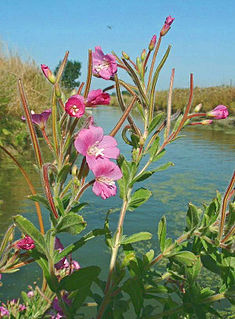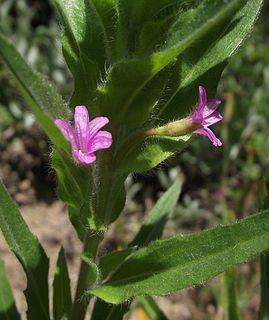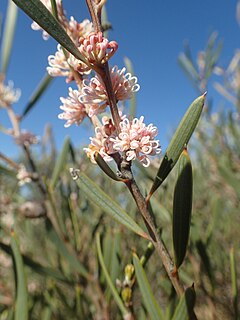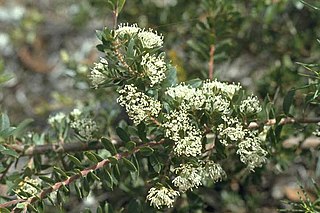
Chamaenerion angustifolium, known in North America as fireweed, in some parts of Canada as great willowherb, and in Britain as rosebay willowherb, is a perennial herbaceous flowering plant in the willowherb family Onagraceae. It is also known by the synonyms Chamerion angustifolium and Epilobium angustifolium. It is native throughout the temperate Northern Hemisphere, including large parts of the boreal forests.

Epilobium is a genus of flowering plants in the family Onagraceae, containing about 197 species. The genus has a worldwide distribution. It is most prevalent in the subarctic, temperate and subantarctic regions, whereas in the subtropics and tropics Epilobium species are restricted to the cool montane biomes, such as the New Guinea Highlands.

Hakea pachyphylla is a shrub in the family Proteaceae which is endemic to the upper Blue Mountains in New South Wales in Australia. Formerly thought to be a Blue Mountains form of Hakea propinqua.

Epilobium hirsutum is a flowering plant belonging to the willowherb genus Epilobium in the family Onagraceae. It is commonly known as the great willowherb, great hairy willowherb or hairy willowherb. Local names include codlins-and-cream, apple-pie and cherry-pie.

Protea aristata, was first collected by the botanists T. P. Stokoe and R. Primos in 1928 near the town of Ladismith in the Cape Province, South Africa. In spite of being locally common in the Seweweekspoort the plant species could not be found again until 1953, prior to which it was considered to be extinct. Protea aristata has become one of South Africa's most famous proteas in spite of its relatively late 'discovery'.

Epilobium anagallidifolium is a species of willowherb known by the common names pimpernel willowherb and alpine willowherb. This small flowering plant has a near-circumboreal distribution and can be found in mountain ranges further south, where grows in alpine climates. It is a perennial found in low clumps rarely exceeding 20 centimeters in height.

Epilobium densiflorum is a species of willowherb known by the common names denseflower willowherb, dense spike-primrose or dense boisduvalia. It is native to western North America from British Columbia to Baja California, where it is found in a variety of habitats. This is an erect annual often exceeding a meter in height with fuzzy green foliage. The pointed leaves are up to 8 centimeters long near the base of the plant, and the upper leaves are generally more hairy than the lower. The stem may branch or not. The top of the stem is occupied by a hairy, leafy, densely flowered inflorescence. Each flower has four deeply notched petals in shades of pinkish purple to nearly white with dark veining, each about a centimeter long. The fruit is a cylindrical capsule about a centimeter long.

Epilobium minutum is a species of willowherb known by the common names little willowherb, chaparral willowherb and desert willowherb. It is also called "smallflower willowherb" in reference to its small size relatively. However that name, in particular the British English variant "small-flowered willowherb", typically refers to Epilobium parviflorum.

Epilobium palustre is a species of willowherb known by the common name marsh willowherb. This plant has a circumboreal distribution, and can be found farther south in mountainous areas.
Ivesia argyrocoma is a species of flowering plant in the rose family that is also known by its common name, silverhair mousetail. It is native to the San Bernardino Mountains of southwestern San Bernardino County, California. A population of Ivesia argyrocoma is also found in Baja California in Mexico; this population may or may not be distinct and further study is required. Ivesia argyrocoma is a small perennial herb producing a clump of fuzzy reddish naked stems that grow horizontal to the ground and a number of tail-like hairy leaves which grow erect and may curl or droop. The stems are 10 centimetres (3.9 in) to 20 centimetres (7.9 in) long. Each leaf is a nearly cylindrical strip of tightly overlapping leaflets arranged around a central rachis up to 8 centimetres (3.1 in) long. The leaflets are green and covered in a dense coat of shiny silver hairs. Most of the leaves emerge from the base of the stem; a few very small ones may emerge farther up the stem. At the tip of the stem is an inflorescence of one or more clusters of glandular flowers. Each flower has generally five green and red, densely silver-haired, triangular sepals and five smaller oval or spoon-shaped white petals. The center of the Ivesia argyrocoma flowers contain twenty yellow-anthered white stamens and several pistils. The fruit is a tiny smooth brown achene.
Epilobium foliosum is a species of flowering plant in the evening primrose family known by the common names leafy willowherb and California willowherb. It is native to parts of western North America from British Columbia through California to Arizona, where it grows in many types of habitat, including disturbed areas.

Epilobium siskiyouense is a rare species of flowering plant in the evening primrose family known by the common names Siskiyou willowherb and Siskiyou fireweed.

Epilobium alsinifolium is a species of willowherb known by the common name chickweed willowherb. This small flowering plant can be found in European arctic regions and further south in mountainous regions with an Arctic climate, as well as in Greenland. It is a perennial found in low clumps approximately 10 to 25 centimeters in height. It has wide, rounded basal leaves and narrower leaves further up the stem. It bears purple or pinkish trumpet-shaped flowers, 7 to 12 millimeters in diameter, and the fruit is a capsule two or three centimeters long.
Epilobium brunnescens is a flowering plant belonging to the willowherb genus Epilobium in the family Onagraceae. It is a small, creeping, perennial plant with white or pale pink flowers. It is native to New Zealand and south-east Australia and has been introduced to Northern Europe. Its common names include New Zealand willowherb in Great Britain and Ireland, creeping willowherb in New Zealand and bog willowherb for the Australian subspecies.

Hakea baxteri, commonly known as fan-leaf hakea , is a shrub in the family Proteaceae native to an area in the Great Southern and Wheatbelt regions of Western Australia. A species noted for its foliage due to its fan-shaped leaves.

Hakea candolleana is a shrub in the family Proteaceae native to areas along the west coast in the Wheatbelt and Mid West regions of Western Australia. A cream-white winter flowering species, useful as a garden ground cover.

Hakea circumalata is a shrub in the family Proteaceae native to an area in the Wheatbelt and Mid West regions of Western Australia. A small shrub producing a profusion of strongly scented pink to red flowers in dense clusters from July to September.

Hakea erecta is a shrub in the family Proteaceae and is endemic to Western Australia. It is a dense rounded shrub with linear twisted leaves and up to 24 pink or white fragrant flowers appearing in leaf axils in spring.

Hakea ruscifolia, commonly known as the candle hakea, is a shrub in the family Proteacea. It has fragrant white flowers, arching branches and spiky foliage. It is endemic to an area in the Peel, Wheatbelt South West, Great Southern and the Goldfields-Esperance regions of Western Australia.















